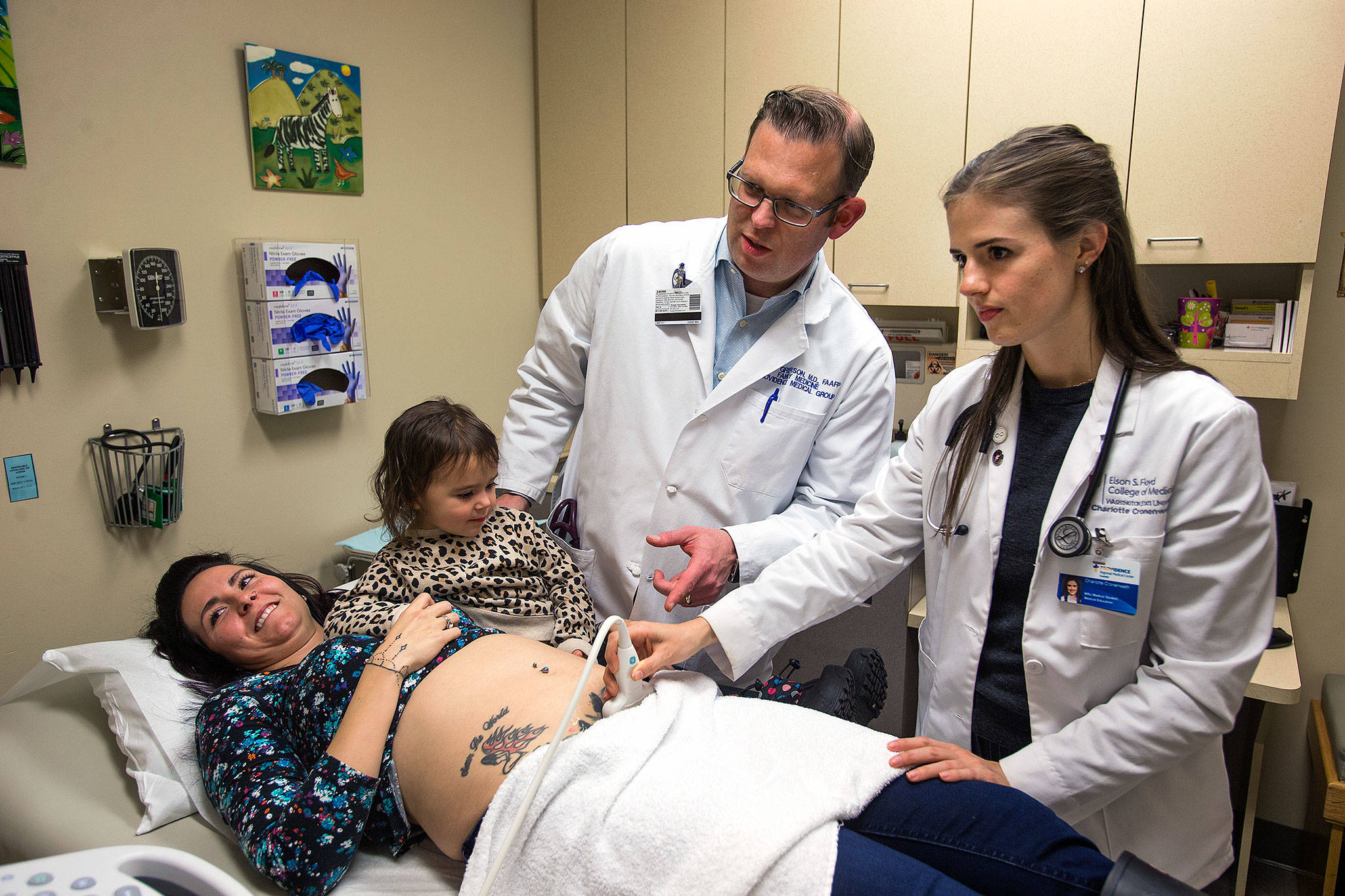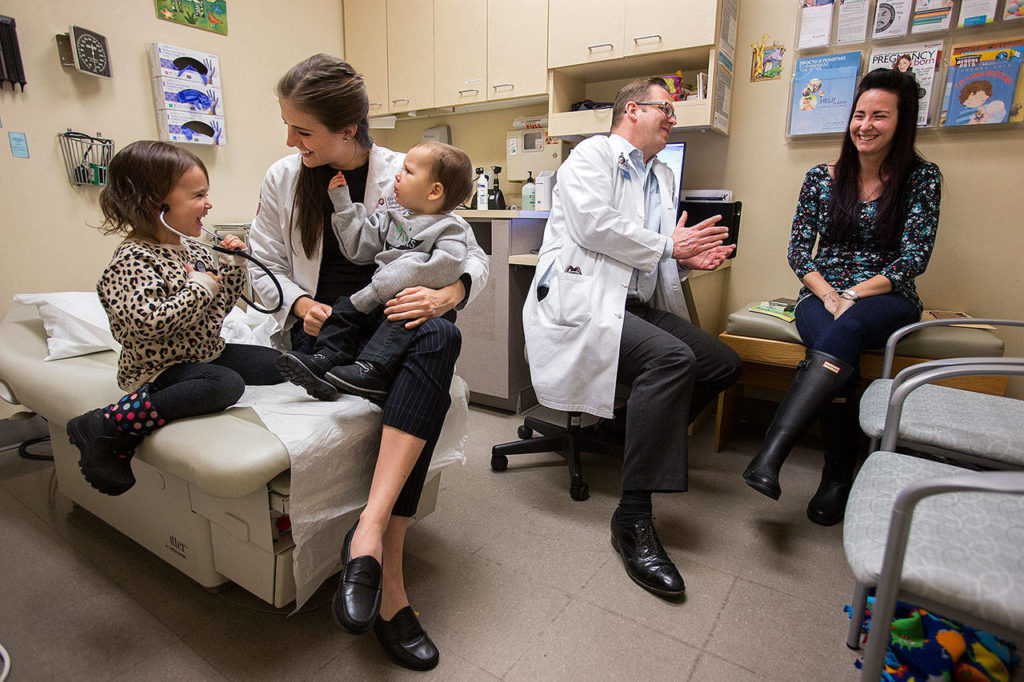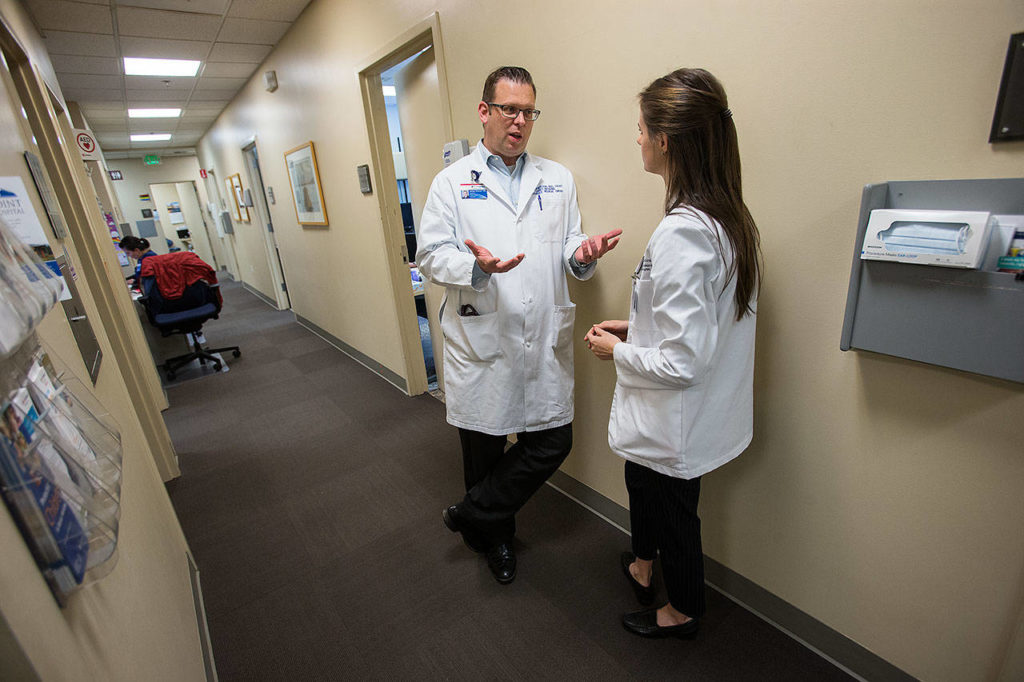By Celeste Gracey / for The Herald
In a parking lot on the corner of Hoyt and Everett avenues, Dr. Jimmy Grierson peels a dirty bandage off a patient’s finger, and she winces as he wipes away pus and dried blood.
His headlamp illuminates what appears to be a cut that’s blistered with infection. She doesn’t like needles but consents to numbing the finger so the doctor can clean the wound.
The backseat of an SUV is the closest thing Grierson, a rural family doctor and medical teacher, has to an exam table. Before he begins, he asks Tina Tanner, who is homeless, to climb in. Draped in a blue pad, her lap functions as a tray. He distracts her with a question about a tattoo, and as she chatters with a voice that barely rises above the traffic, he snips away dead skin and paints her finger in iodine.
Street medicine is a rare practice and happens through the generosity of those physicians focused on under-served communities. While the world can always hope for more Dr. Griersons, Washington State University’s new medical program wants to train more students like him right in the places they’re needed most, including the heart of Snohomish County.
Its program couldn’t be more timely. A shortage of primary care physicians is expected to intensify over the next decade. Vulnerable populations, such as low-income Everett neighborhoods and rural towns along U.S. 2, are expected to take the biggest hit, especially given that they already have a shortage.
For organizations like the Community Health Center, which has seven Snohomish County clinics focused on helping under-insured families, recruiting new physicians has always been a challenge, said Dr. Tom Tocher, the center’s chief clinical officer.
Medical school graduates are coming out of training with heavy student debt, and as the county grows, so does the cost of housing, which puts pressure on doctors to choose specialties with higher pay, he said.
The situation isn’t unique to Snohomish County. Take a map of Washington state and with a fat highlighter blot out the areas around I-5 from Joint Base Lewis-McChord through Snohomish County. Except for Everett and the Tulalip Indian Reservation, this represents the only parts of the state not yet dealing with a shortage of primary care physicians.
WSU’s new school in Spokane, the Elson S. Floyd College of Medicine, hopes to address the shortage by recruiting more students from rural and underserved communities and embedding them in primary care clinics, including CHC. The idea is that graduates are more likely to return to where they train or where they were raised. The school is so focused on the state’s needs, it doesn’t even have out-of-state tuition rates.
While the program will help with the growing shortage, it’s going to be another five to six years before the first class will be ready to hire, Tocher said.
After undergraduate education, it takes seven to eight years to train a fully-licensed doctor and more for some specialties. Lawmakers must think a decade into the future, when it comes to funding medical education.
“I think capacity for medical students hasn’t grown much since I graduated many years ago,” Tocher said.
The average age of practicing physicians is a concerning number. About 40 percent of Snohomish County’s doctors are 55 and older. That jumps to about 47 percent in Skagit County and 64 percent in Island County, according to a University of Washington Center for Health Workforce Studies report.
As baby boomer doctors reach retirement, the need for medical services from their generation will also increase.
For families that have strong health insurance, the worsening shortage might mean being asked to go to urgent care, because their regular clinic is booked out for the week. For those who are already struggling with access, it may mean preventable illnesses turn into emergency room visits, said Dr. Larry Schecter, associate dean of clinical education and head of the WSU clinical campus in Everett.
While everyone agrees there’s a need, the Floyd College of Medicine continues to battle for funding. The state House and Senate each provided $10.8 million in their budgets to open the school’s four clinical campuses this fall. In their third and fourth years, students leave Spokane to train at these locations.
They have yet to provide the $3.6 million needed to expand its next class from 60 to 80 students, which is the school’s “sweet spot” for cost efficiency.
“It’s not perfect, but it’s working in the right direction,” said Rep. Mike Sells, D-Everett, who serves on the House Capital Budget Committee.
Assuming the average physician cares for at least 1,800 patients, 20 students represent about 36,000 patients per year. That didn’t go unnoticed. Republican senators proposed an amendment to the Democrats’ budget that would have provided $3.6 million to grow the program. It rallied bipartisan support, including a vote from Sen. Marko Liias, D-Lynnwood, who originally co-sponsored the bill that allowed WSU to launch the medical program a few years ago. The amendment failed by two votes.
While many in the Democratic caucus are committed to eventually funding the expansion, they’re content for now to just fund the school’s needs at its current size, he said.
The House and Senate are expected to debate their budgets for the next few weeks, before sending a final version to the governor by April 28. This presents an opportunity to change minds, Liias said.
Recruiting rural doctors
At the Providence Medical Group Marysville Clinic, Grierson finishes up an exam on a child. With the baby’s fists still tightly clutching his fingers, he intently looks up at the mother. During postpartum months, women can be particularly vulnerable to depression and caring for an infant can be isolating.
He asks how she’s doing, and she brushes off the question. Not believing her, he asks again. She hesitates, but like a child confessing to something her parents already know, she confides that her partner is struggling with addiction.
Most of Grierson’s patients are related to another patient. In the same family he may deliver a baby and then shortly after ease the suffering of a dying great grandparent. It’s the nature of rural family medicine, and his practice is better for it. In this case, they plan how to help the woman’s partner which, in turn, could benefit the whole family.
If you do it well, you can serve people compassionately, he said. As a Floyd College of Medicine teacher, he believes he can instill these values in his students.
“We want physicians who can talk to patients and their families,” Schecter said. “We want physicians who can listen.”
To train students with the altruism and compassion that Grierson often exhibits, the school focuses on cultural and humanistic qualities in their final admissions decisions. Academic achievement is used more as a threshold to ensure students will succeed in the program. As a result, the average student is a couple years older than at most schools, Schecter said. “I wish I could tell you how different our students are.”
Even so, they don’t have space for all their well-qualified candidates, who will likely get into medical schools elsewhere, which means they’re less likely to return, he said.
In addition to medical school debt, the Floyd School of Medicine theorizes that insufficient exposure to primary care during training may also be playing a role in the shortage. Most medical programs center their clinical education in big cities, where students spend the same amount of time training in any specialty as they do in primary care. WSU is launching a unique longitudinal program, in which instead of the traditional six-week rotation in family practice, students spend one day a week with a primary care physician for about a year, Schecter said.
This allows students to start forming relationships with patients and their families, adding a little more humanity to their training, Grierson added.
The Floyd School’s focus on rural medicine is also unusual in that it views its four clinical campuses more as gateways to small communities than places to set up camp. From Everett, the students will be sent to Skagit, Island, Whatcom and San Juan counties. The hope is that some will return to these communities to practice.
In rural medicine, doctors tend to do more procedures and refer patients to specialists less often. To Grierson, the variety makes it more interesting.
Unlike urban doctors who can fade into a sea of anonymity, doctors in less populated areas are de facto community leaders and their clinics are like a local church, but of medicine. The doctors are not just called upon to be scientists, but counselors and advocates. Grierson is often proactive, checking on patients after seeing them in the community or hearing about them from others.
Back in the parking lot clinic in Everett, Grierson digs through a bag of antibiotics. He knows its unlikely he’ll see Tanner again, and he wants to make sure she has treatment, if the infection worsens.
Asked why he volunteers with Mercy Watch on the streets and why he launched a free clinic in Stanwood, he quotes Mother Teresa.
Then he says, “There’s an immense amount of suffering in the world, and there’s an immense amount of resources that are not being utilized.”
With a smile, he said that he sounds a lot like Robin Hood.
Except he is the resource being given to the poor.
Celeste Gracey is a freelance journalist and a former reporter for Sound Publishing.
Talk to us
> Give us your news tips.
> Send us a letter to the editor.
> More Herald contact information.



























